Dear Zazie, First, Happy Halloween! Tick or treat? We are large fans of Halloween here at TLC. Particularly, we are fans of scary movies. The old ones are the best and Hitchcock’s, are the best of the best.
Here is today’s Lovers’ Chronicle from Mac Tag dedicated to his muse. Has love left you without mercy? Rhett
The Lovers’ Chronicle
Dear Muse,
© copyright 2020 mac tag/cowboy coleridge all rights reserved
trick or treat
well, the treat
is all mine
my treat
is simple
i know
i know that you
are a rare,
wonderful woman
and people who see you,
at the gym,
or the market,
or walkin’ down the street
have no idea
just how wonderful you are
but i know
and that is my treat
……
this week,
been watchin’ plenty
of Hitchcock movies
she often looked like
a blonde leadin’ lady
from one of his films
dependin’
on her mood
and her hair
it might be
Grace, or Kim,
or Janet, or Tippi
who will she be,
tonight
© copyright 2018 mac tag/cowboy coleridge all rights reserved
needless to say,
what is so needed
to be said
what ails thee
on all hallows’ eve
are you without
the only one
who can make you
feel alive
the only one
who can take
your hand and calm
your wanderin’ spirit
on this, all hallows’ eve
are you without
the one
© copyright 2017 mac tag/cowboy Coleridge all rights reserved
| John Keats | |
|---|---|
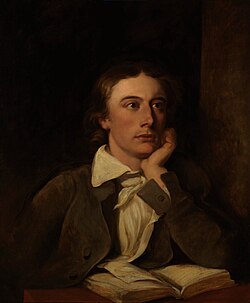
Portrait of John Keats by William Hilton. National Portrait Gallery, London
|
|
Today is the birthday of John Keats (Moorgate, London; 31 October 1795 – 23 February 1821 Rome); Romantic poet. He was one of the main figures of the second generation of Romantic poets, along with Lord Byron and Percy Bysshe Shelley, despite his work having been in publication for only four years before his death.
Although his poems were not generally well received by critics during his lifetime, his reputation grew after his death, and by the end of the 19th century, he had become one of the most beloved of all English poets. He had a significant influence on a diverse range of poets and writers. Jorge Luis Borges stated that his first encounter with Keats’s work was the most significant literary experience of his life.
The poetry of Keats is characterised by sensual imagery, most notably in the series of odes. This is typical of romantic poets, as they aimed to accentuate extreme emotion through the emphasis of natural imagery. Today his poems and letters are some of the most popular and most analysed in English literature.

On First Looking into Chapman’s Homer
Much have I travell’d in the realms of gold,
And many goodly states and kingdoms seen;
Round many western islands have I been
Which bards in fealty to Apollo hold.
Oft of one wide expanse had I been told
That deep-browed Homer ruled as his demesne;
Yet did I never breathe its pure serene
Till I heard Chapman speak out loud and bold:
Then felt I like some watcher of the skies
When a new planet swims into his ken;
Or like stout Cortez when with eagle eyes
He star’d at the Pacific — and all his men
Look’d at each other with a wild surmise —
Silent, upon a peak in Darien.
The sonnet “On First Looking into Chapman’s Homer”
October 1816
My heart aches, and a drowsy numbness pains
My sense, as though of hemlock I had drunk,
Or emptied some dull opiate to the drains
One minute past, and Lethe-wards had sunk:
‘Tis not through envy of thy happy lot,
But being too happy in thine happiness,—
That thou, light-winged Dryad of the trees,
In some melodious plot
Of beechen green, and shadows numberless,
Singest of summer in full-throated ease.
First stanza of “Ode to a Nightingale”,
May 1819
Keats befriended Isabella Jones in May 1817, while on holiday in the village of Bo Peep, near Hastings. She is described as beautiful, talented and widely read, not of the top flight of society yet financially secure, an enigmatic figure who would become a part of Keats’s circle. Throughout their friendship Keats never hesitates to own his sexual attraction to her, although they seem to enjoy circling each other rather than offering commitment. He writes that he “frequented her rooms” in the winter of 1818–19, and in his letters to George says that he “warmed with her” and “kissed her”. The themes of “The Eve of St. Agnes” and “The Eve of St Mark” may well have been suggested by her, the lyric Hush, Hush! [“o sweet Isabel”] was about her, and that the first version of “Bright Star” may have originally been for her. In 1821, Jones was one of the first in England to be notified of Keats’s death.
Letters and drafts of poems suggest that Keats first met Frances (Fanny) Brawne between September and November 1818. She shared her first name with both Keats’s sister and mother, and had a talent for dress-making and languages as well as a natural theatrical bent. During November 1818 she developed an intimacy with Keats.
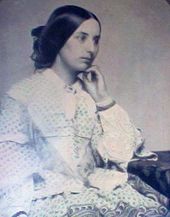
Keats began to lend Brawne books, such as Dante’s Inferno, and they would read together. He gave her the love sonnet “Bright Star” (perhaps revised for her) as a declaration. It was a work in progress which he continued at until the last months of his life, and the poem came to be associated with their relationship. From this point there is no further documented mention of Isabella Jones. Sometime before the end of June, he arrived at some sort of understanding with Brawne, far from a formal engagement as he still had too little to offer, with no prospects and financial stricture. Keats endured great conflict knowing his expectations as a struggling poet in increasingly hard straits would preclude marriage to Brawne. Their love remained unconsummated. Darkness, disease and depression surrounded him, reflected in poems such as “The Eve of St. Agnes” and “La Belle Dame sans Merci” where love and death both stalk. “I have two luxuries to brood over in my walks;” he wrote to her, “…your loveliness, and the hour of my death.”
In one of his many hundreds of notes and letters, Keats wrote to Brawne on 13 October 1819: “My love has made me selfish. I cannot exist without you – I am forgetful of every thing but seeing you again – my Life seems to stop there – I see no further. You have absorb’d me. I have a sensation at the present moment as though I was dissolving – I should be exquisitely miserable without the hope of soon seeing you … I have been astonished that Men could die Martyrs for religion – I have shudder’d at it – I shudder no more – I could be martyr’d for my Religion – Love is my religion – I could die for that – I could die for you.”
Tuberculosis took hold and he was advised by his doctors to move to a warmer climate. In September 1820 Keats left for Rome knowing he would probably never see Brawne again. After leaving he felt unable to write to her or read her letters. He died there five months later. None of Brawne’s letters to Keats survive.
It took a month for the news of his death to reach London, after which Brawne stayed in mourning for six years. In 1833, more than 12 years after his death, she married. She outlived Keats by more than 40 years.
Keats was buried in the Protestant Cemetery, Rome. His last request was to be placed under a tombstone bearing no name or date, only the words, “Here lies One whose Name was writ in Water.” Severn and Brown erected the stone, which under a relief of a lyre with broken strings, includes the epitaph:
- “This Grave / contains all that was Mortal / of a / Young English Poet / Who / on his Death Bed, in the Bitterness of his Heart / at the Malicious Power of his Enemies / Desired / these Words to be / engraven on his Tomb Stone: / Here lies One / Whose Name was writ in Water. 24 February 1821″
The text bears an echo from Catullus LXX
- “Sed mulier cupido quod dicit amanti / in vento et rapida scribere oportet aqua” (What a woman says to a passionate lover / should be written in the wind and the running water).
Close bosom-friend of the maturing sun
Conspiring with him how to load and bless
With fruit the vines that round the thatch-eaves run;
To bend with apples the moss’d cottage-trees,
And fill all fruit with ripeness to the core;
To swell the gourd, and plump the hazel shells
With a sweet kernel; to set budding more,
And still more, later flowers for the bees,
Until they think warm days will never cease,
For Summer has o’er-brimm’d their clammy cells.
First stanza of “To Autumn”,
September 1819
The final stanza “To Autumn”:
Where are the songs of Spring? Ay, where are they?
Think not of them, thou hast thy music too,-
While barred clouds bloom the soft-dying day,
And touch the stubble-plains with rosy hue;[79]
In honour of Keats, here is “La Belle Dame Sans Merci” (Beautiful Woman Without Mercy):
La Belle Dame Sans Merci
Ah, what can ail thee, wretched wight,
Alone and palely loitering?
The sedge is withered from the lake,
And no birds sing.
Ah, what can ail thee, wretched wight,
So haggard and so woe-begone
The squirrel’s granary is full,
And the harvest’s done.
I see a lily on thy brow
With anguish moist and fever dew,
And on thy cheek a fading rose
Fast withereth too.
I met a lady in the meads,
Full beautiful, a faery’s child:
Her hair was long, her foot was ligh,
And her eyes were wild.
I set her on my pacing steed,
And nothing else saw all day long;
For sideways would she lean, and sing
A faery’s song.
I made a garland for her head,
And bracelets too, and fragrant zone;
She looked at me as she did love,
And made sweet moan.
She found me roots of relish sweet,
And honey wild, and manna dew,
And sure in language strange she said,
“I love thee true!”
She took me to her elfin grot,
And there she gazed and sighed deep,
And there I shut her wild, sad eyes—
So kissed to sleep.
And there we slumbered on the moss,
And there I dreamed, ah! woe betide,
The latest dream I ever dreamed
On the cold hill side.
I saw pale kings, and princes too,
Pale warriors, death-pale were they all;
Who cried—“La belle Dame sans merci
Hath thee in thrall!”
I saw their starved lips in the gloam,
With horrid warning gaped wide,
And I awoke and found me here,
On the cold hill side.
And that is why I sojourn here,
Alone and palely loitering,
Though the sedge is withered from the lake,
And no birds sing.
The Song of the Day is “La Belle Dame Sans Merci” music by Charles Villiers Stanford sung by Ian Bostridge.
Today is the birthday of Natalie Barney (Natalie Clifford Barney; Dayton, Ohio; October 31, 1876 – February 2, 1972 Paris; salonist, playwright, poet and novelist who lived as an expatriate in Paris.
Barney’s salon was held at her home at 20 rue Jacob in Paris’s Left Bank for more than 60 years and brought together writers and artists from around the world, including many leading figures in French literature along with American and British Modernists of the Lost Generation. She worked to promote writing by women and formed a “Women’s Academy” (L’Académie des Femmes) in response to the all-male French Academy while also giving support and inspiration to male writers from Remy de Gourmont to Truman Capote.
She was openly lesbian and began publishing love poems to women under her own name as early as 1900, considering scandal as “the best way of getting rid of nuisances” (meaning heterosexual attention from young men). She wrote in both French and English. In her writings she supported feminism and pacifism. She opposed monogamy and had many overlapping long and short-term relationships, including on-and-off romances with poet Renée Vivien and dancer Armen Ohanian and a 50-year relationship with painter Romaine Brooks. Her life and love affairs served as inspiration for many novels written by others, ranging from the salacious French bestseller Idylle Saphique by Liane de Pougy to The Well of Loneliness by Radclyffe Hall, perhaps the most famous lesbian novel of the twentieth century.
| Marie Laurencin | |
|---|---|

Marie Laurencin, c. 1912, Paris
|
|
And today is the birthday of Marie Laurencin (Paris 31 October 1883 – 8 June 1956 Paris); painter and printmaker. She became an important figure in the Parisian avant-garde as a member of the Cubists associated with the Section d’Or.
She became romantically involved with the poet Guillaume Apollinaire, and has often been identified as his muse. Laurencin had important connections to the salon of the American expatriate and famed lesbian writer Natalie Clifford Barney. She had heterosexual and lesbian affairs.
During the First World War, Laurencin left France for exile in Spain with her German-born husband, Baron Otto von Waëtjen, since through her marriage she had automatically lost her French citizenship. The couple subsequently lived together briefly in Düsseldorf.
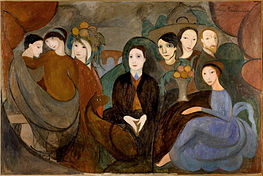
-
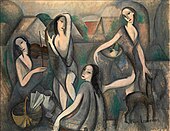
1910-11, Les jeunes filles (Jeune Femmes, Young Girls), oil on canvas, 115 x 146 cm. Exhibited Salon des Indépendants, 1911, Moderna Museet, Stockholm
-

1911, La Toilette des jeunes filles (Die Jungen Damen), black and white photograph. Exhibited at the 1913 Armory Show, New York, Chicago and Boston
-
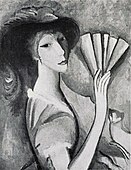
1912, Femme à l’éventail (Woman with a Fan), black and white photograph published in Albert Gleizes, Jean Metzinger, Du “Cubisme”, Edition Figuière, Paris, 1912
-
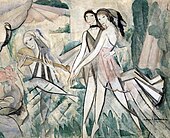
1913, Le Bal élégant, La Danse à la campagne
-

1921, Portrait de Jean Cocteau
Mac Tag
Follow us on twitter @cowboycoleridge

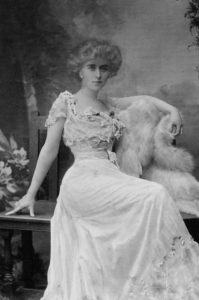
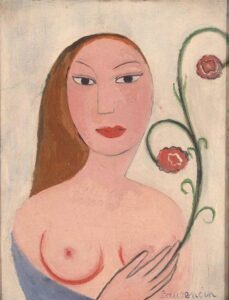
No Comments on "The Lovers’ Chronicle 31 October – without – verse by John Keats – birth of Natalie Barney – art by Marie Laurencin"